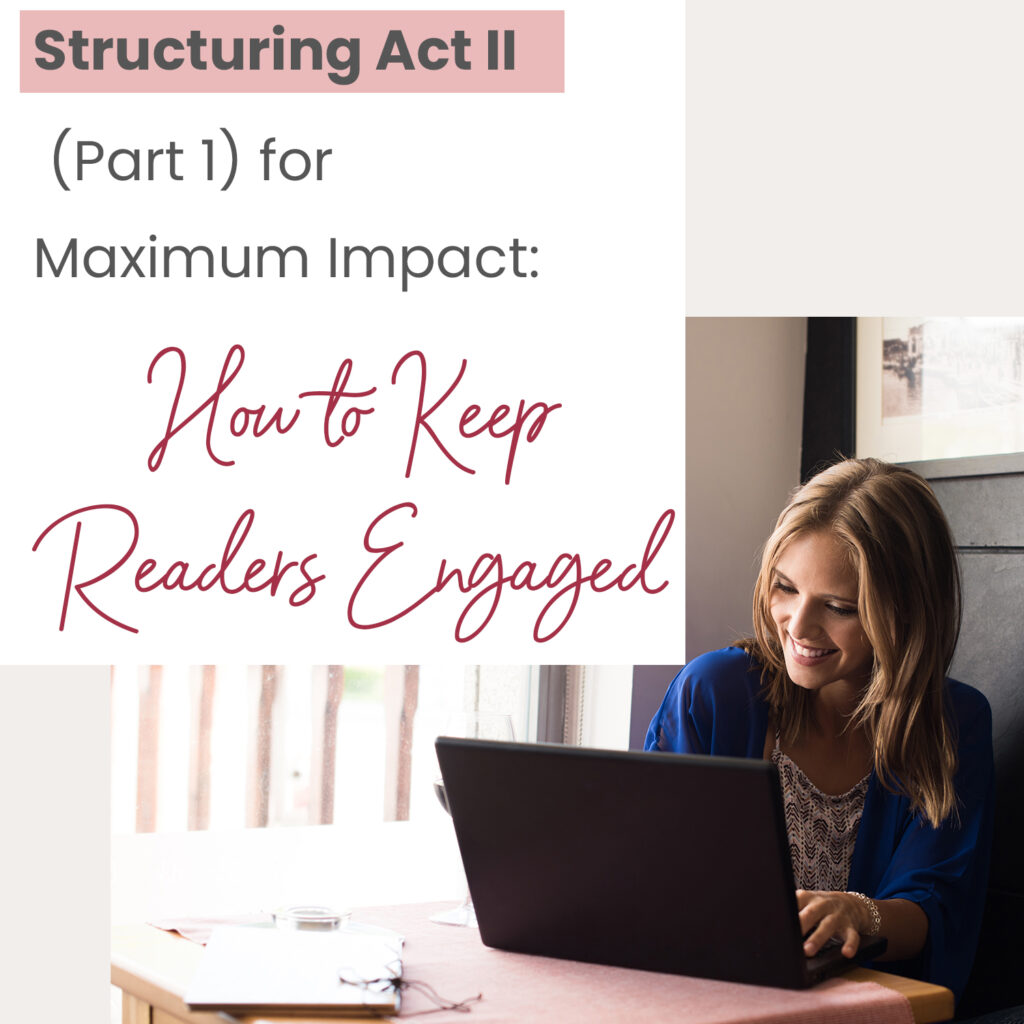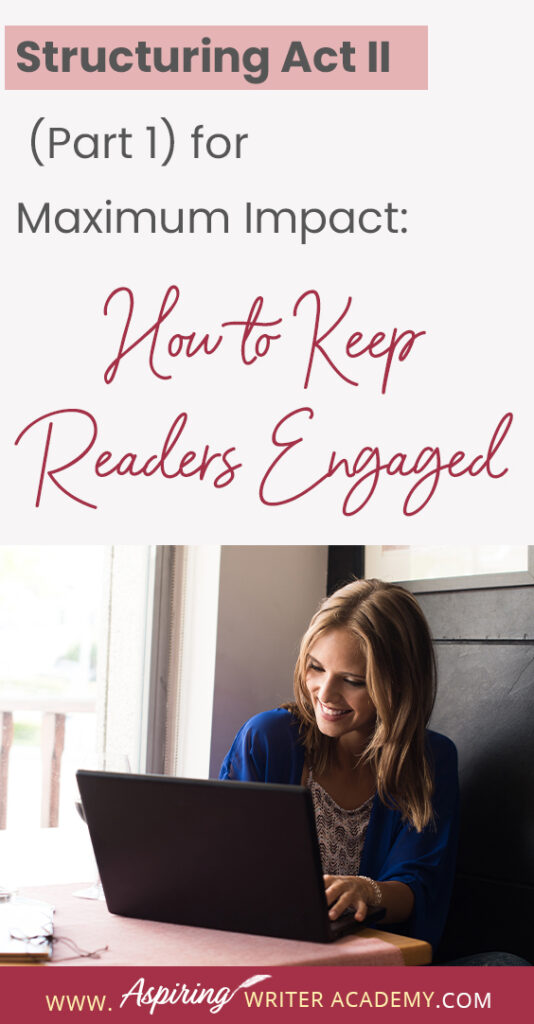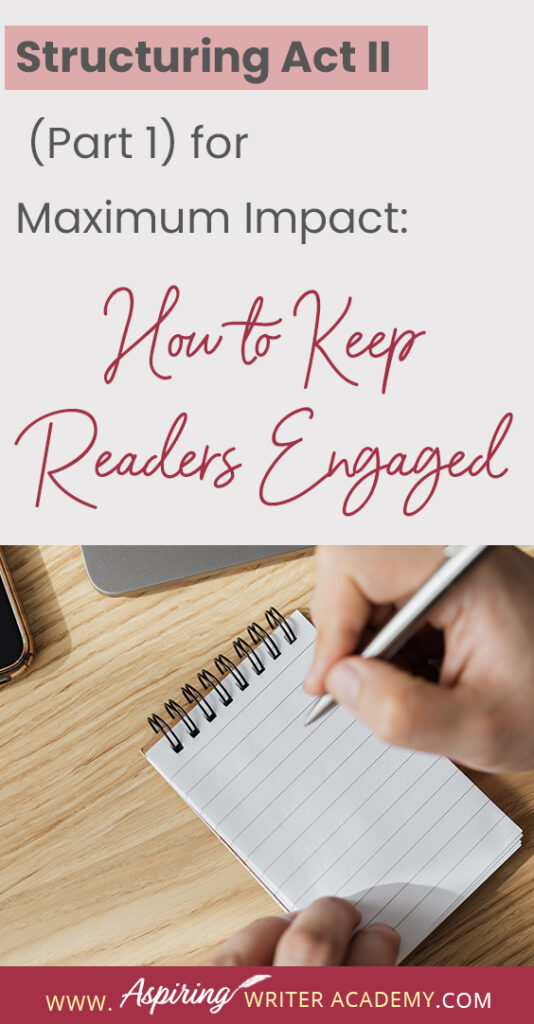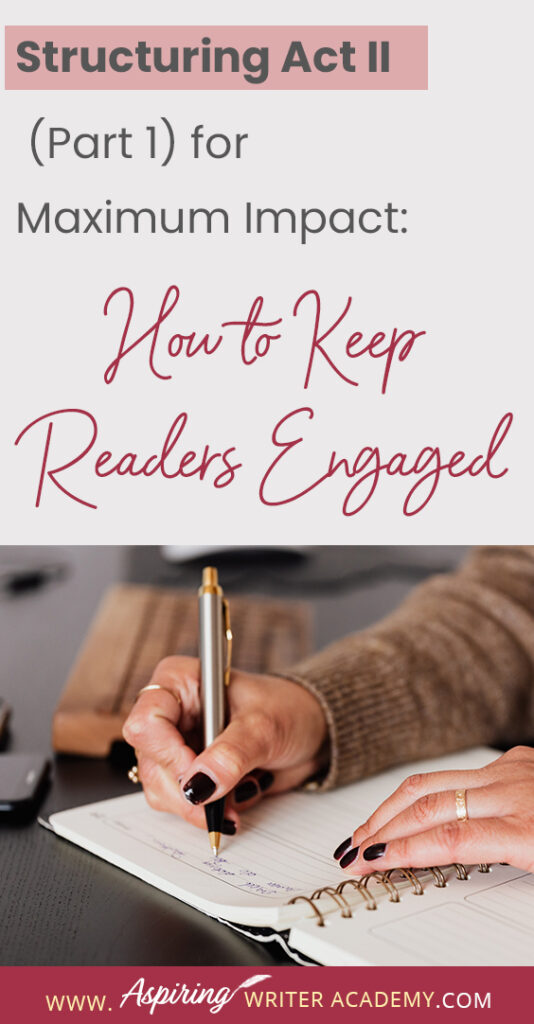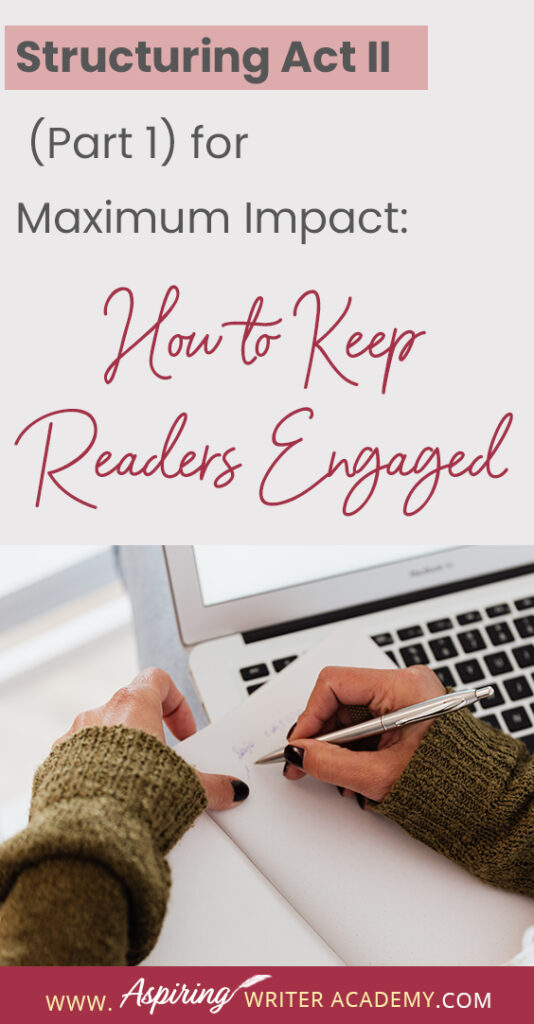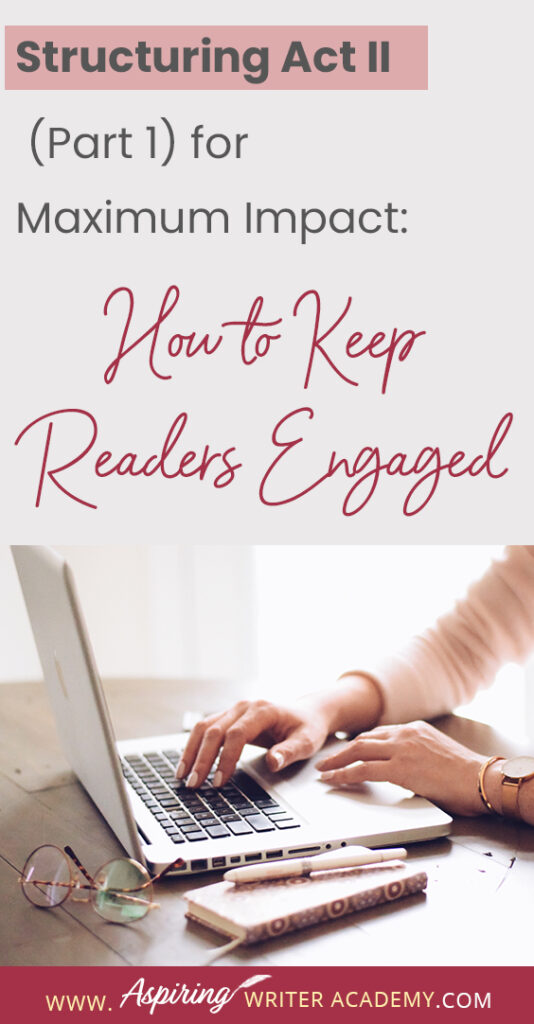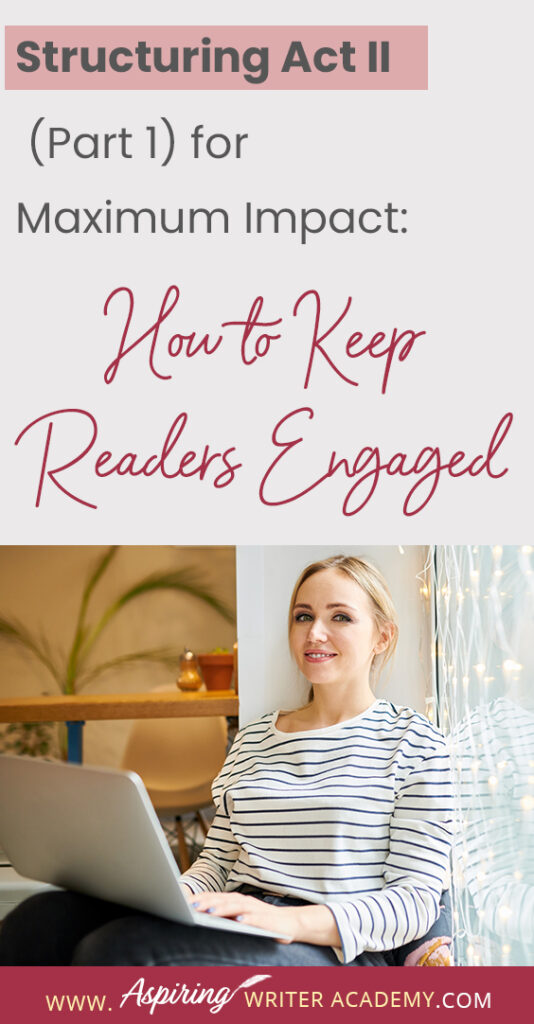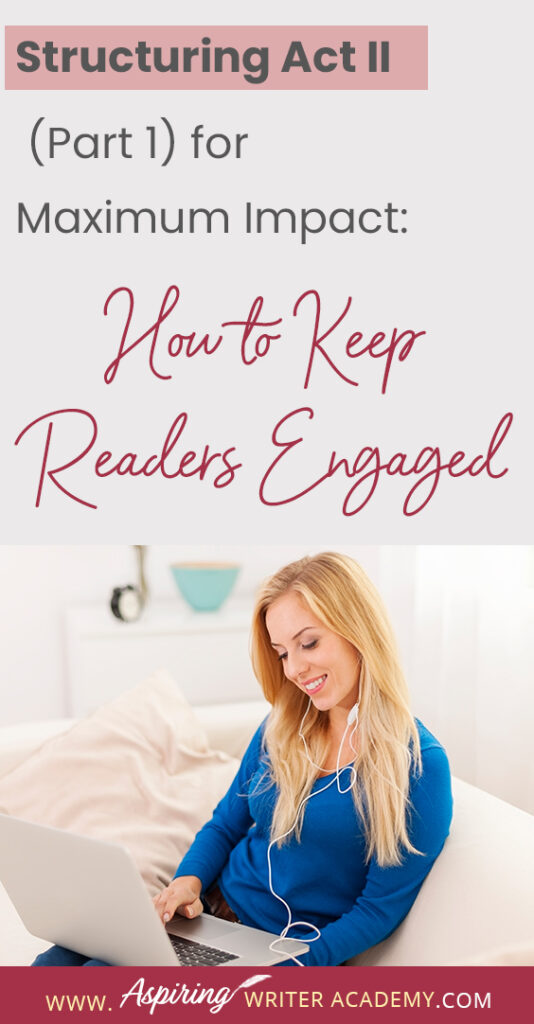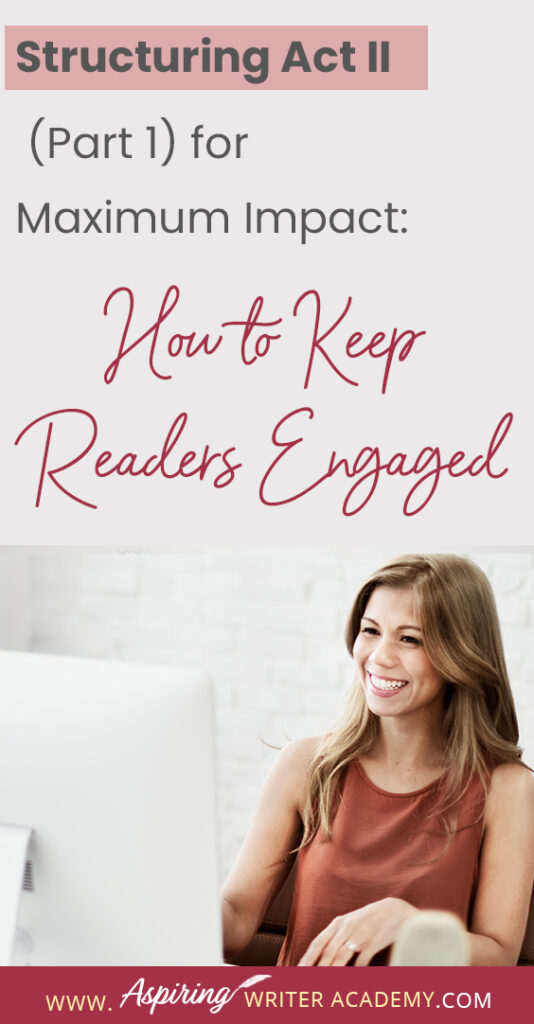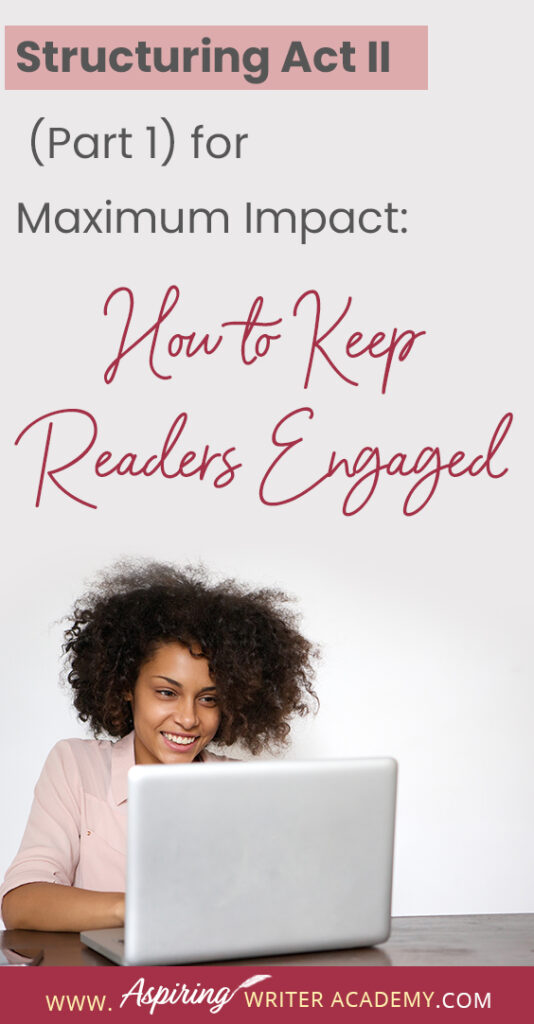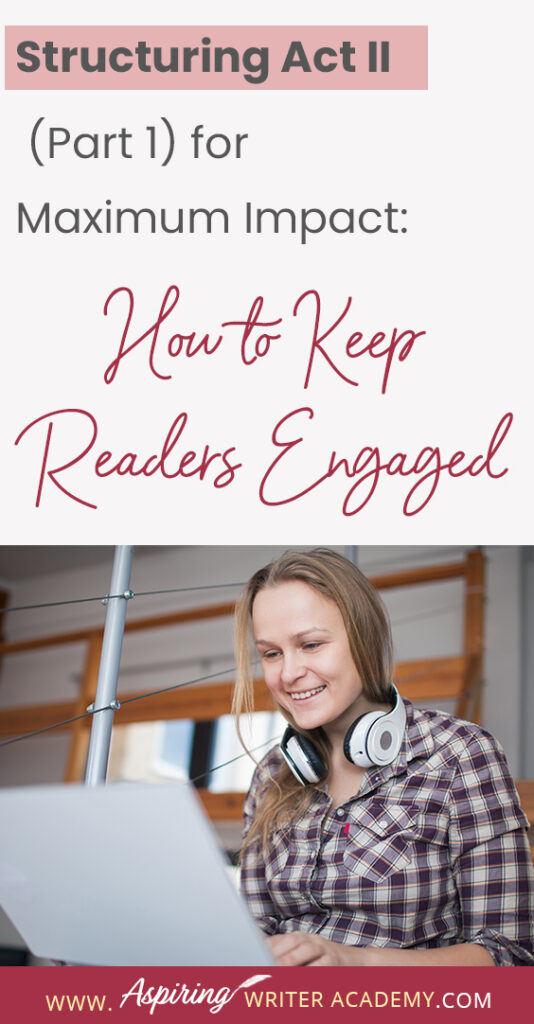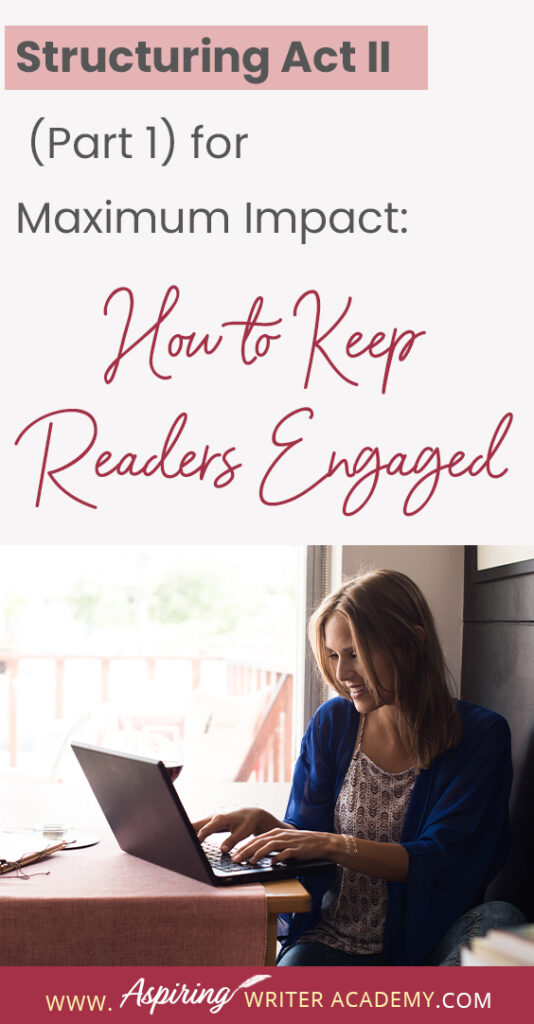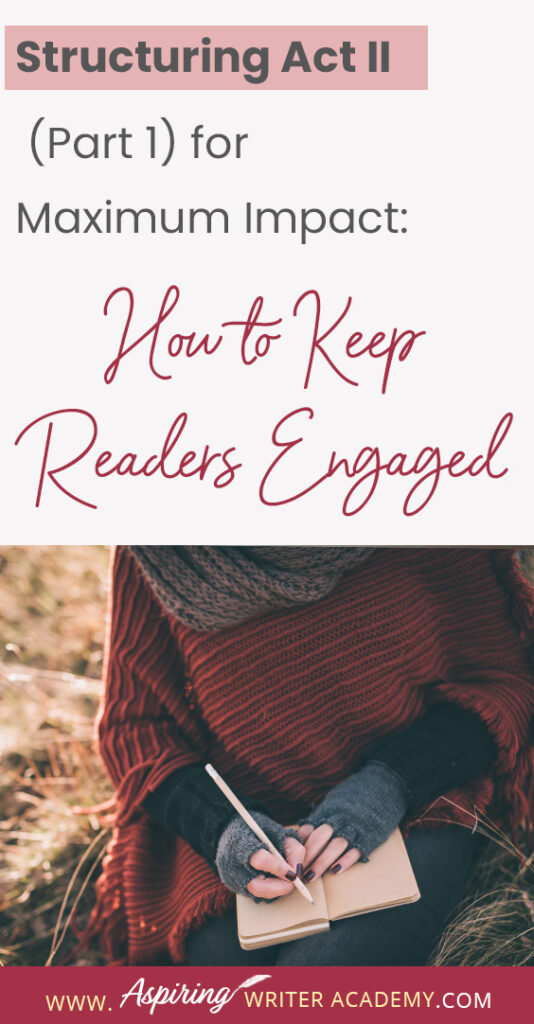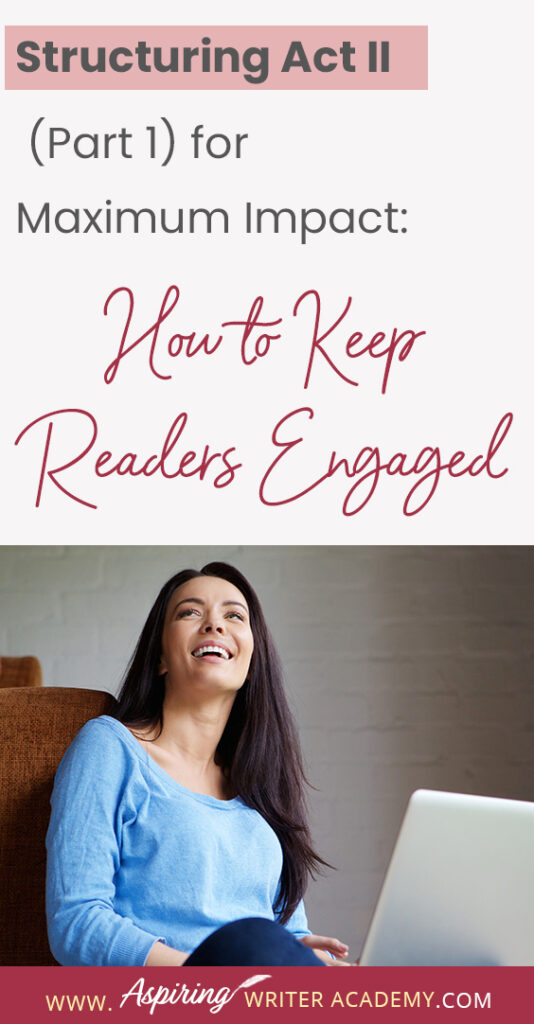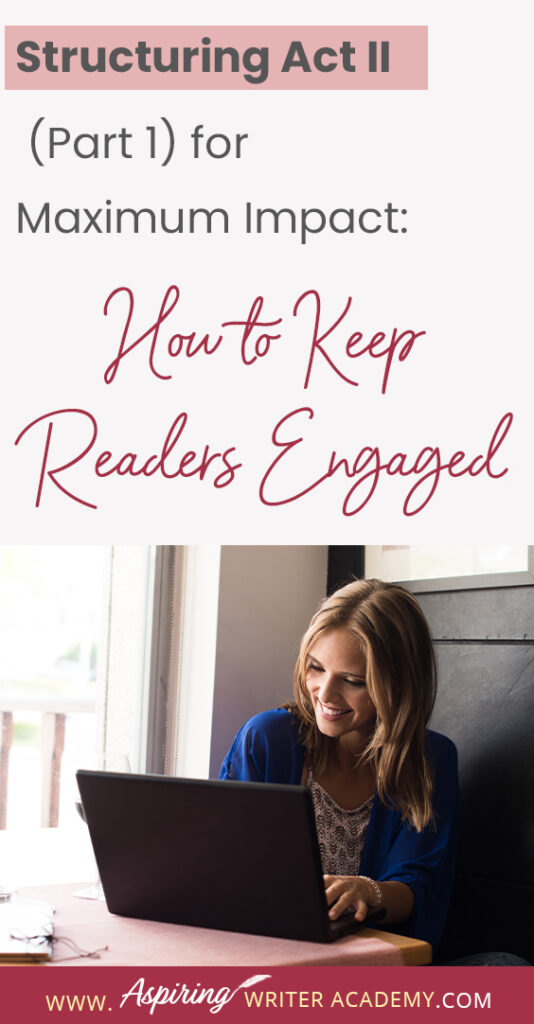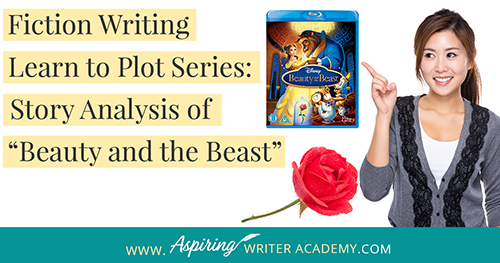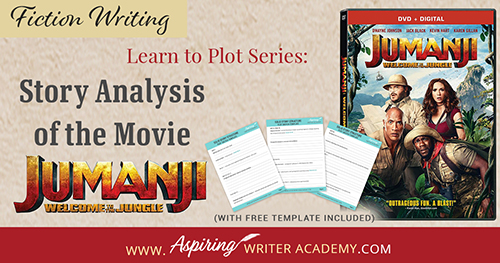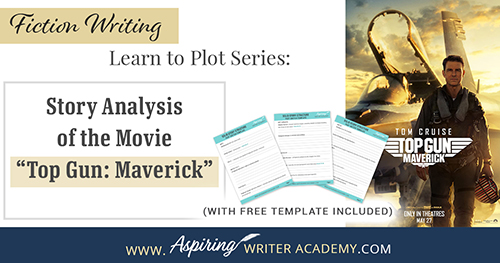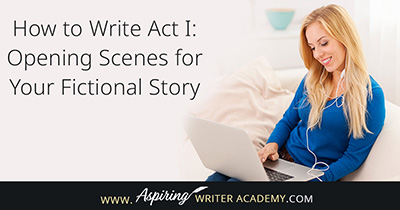Structuring Act II (Part 1) for Maximum Impact: How to Keep Readers Engaged
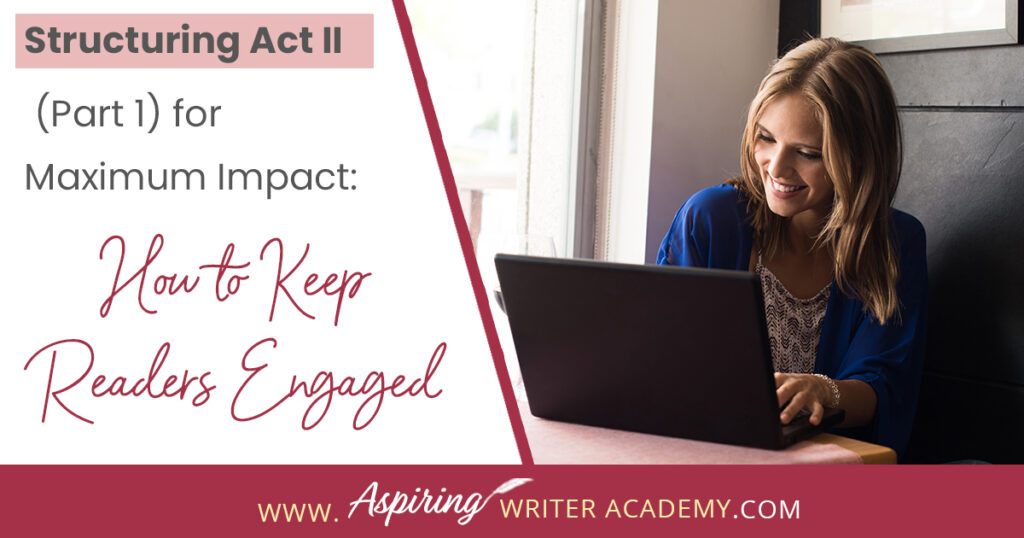
When using the 3-Act-Structure in fiction writing, Act I begins the story, and Act III contains the story ending. But what happens in the middle of the story? Are there specific turning points that should be included?
In Structuring Act II (Part 1) for Maximum Impact: How to Keep Readers Engaged, we cover the key components of the first half of Act II from the Inciting Incident to the Novel Midpoint to help you create a memorable fictional story to keep readers engaged and turning pages.
Why is Act II so hard to write?
Many writers like to throw words on the page without adhering to a structured outline or guide for writing a novel. As a result, they tend to get lost in Act II, not knowing what should come next. While Act I and Act III consist of only a few chapters, Act II takes up the entire middle body of the story which can include 10 to 15 chapters or more.
However, if you follow a traditional 3-Act-Structure there are several key components used in popular fiction that you can implement to ensure you write a story with maximum impact to keep readers engaged.
Follow along as we discuss Structuring Act II (Part 1) of your fictional novel in 3 steps:
1. Structuring Act II (Part 1) for Maximum Impact: Key components of the Protagonist’s Story Journey
2. What is a Pinch Point? How many Pinch Points should be included in Act II? And how can Pinch Point #1 be used to motivate your character when structuring Act II (Part 1) for maximum impact?
3. How to keep readers engaged and turning pages by raising the stakes and giving your character a Temporary Triumph followed by an unexpected Midpoint Reversal.

1) Structuring Act II (Part 1) for Maximum Impact: Key components of the Protagonist’s Story Journey
Act II starts right after the main character makes the decision to go on the story journey to solve the problem the antagonist or villain presented him in the beginning of the book.
The main character (the protagonist) must overcome this problem or there will be dire consequences. Sometimes the decision to act involves traveling to a new location. Or the character might need to go through some kind of door or passage or portal. Perhaps the character starts a new job or joins a new group. The protagonist’s game plan to achieve his goal and overcome the opposition takes him out of his comfort zone. He or she will need to face something new.
When structuring Act II, it helps to divide it up into Part 1 and Part 2. Not only because Act II is so large, but because the first half of Act II is very different than the second half. During Part 1 of Act II the protagonist is learning new skills, learning to navigate his new world or understand the situation he is in. The protagonist tends to be more reactive. However, in the second half of Act II, the protagonist uses the skills and newfound knowledge he has gained in the first half to be more proactive.
What is the structure of Act II (Part 1)?
- The protagonist reacts to the new situation or setting. How is his life different than it was before he was hit with the Inciting Incident problem brought on by the antagonist? What first step must he now take? What is his game plan? What must he now attempt to do?
- The protagonist may need to learn new skills or gather a ‘team’ to help him. The new team may have to learn how to work together.
- As the protagonist takes steps to achieve his goal of overcoming the opposition or the story problem, he faces many challenges that test his strengths and his weaknesses, and his relationships with others. The developments in the story may also challenge his views, his beliefs, and his perspective.
- Escalating events give the protagonist the opportunity to taste both success and failure. As the protagonist takes steps to achieve his goal, the antagonist takes steps to block him at every turn. Sub-characters serve to either help or hinder the protagonist in this back-and-forth battle.
- Halfway through Act II (Part 1) your protagonist may encounter a moment that tugs on his emotions and reminds him of all he could lose if he fails to overcome the opposition and achieve his goal. This is Pinch Point #1.
- Right before the midpoint of Act II (which is also the halfway point of your novel) the protagonist may experience an external win and think he is well on his way to solving his problem. This is called the Temporary Triumph.
- It is only a temporary triumph because in the very next scene, at the Midpoint Reversal, the protagonist will find that it was not a real win or triumph at all. Something big and unexpected happens to turn the story around in a different direction. This will launch the protagonist into the second half of Act II.
2) What is a Pinch Point? How many Pinch Points should be included in Act II? And how can Pinch Point #1 be used to motivate your character when structuring Act II Part I for maximum impact?
* A Pinch Point is an emotional moment in the story that causes the protagonist to pause and think about the consequences tied to the achievement of his story goal.
The protagonist may see or hear something that causes him to react emotionally. The character may have to confront a heart-tugging dilemma. The event ‘pinches’ his emotions and pulls on his heart-strings and reminds him why his goal and this journey is important to him. The Pinch Point motivates the protagonist to continue forward with renewed resolve. He will not give up!
* There are usually Two Pinch Points in a fictional novel. The first occurs halfway through Act II (Part 1) and the second occurs about halfway through Act II (Part 2). While Pinch Point #1 may lead the protagonist to see all he has to lose if he does not press forward with his goal, Pinch Point #2 leads him to see all he might gain.
* These Pinch Points not only tug on the heart of the protagonist but serve to tug on the heart of the reader whose time and emotions are invested in this fictional character. For maximum impact, create poignant, emotional Pinch Points that rise naturally from the story and give the character a reason to continue to pursue their story goal.
* Remember, when structuring Act II (Part 1) the first pinch point—Pinch Point #1—the character looks back at the past and considers all he has to lose if he does not win.
Example 1: From Disney’s Beauty and the Beast
Belle runs away from the Beast’s castle and is attacked by wolves. Her life is in danger, but the Beast saves her, and is badly hurt. Belle can run off to freedom but remembers her promise to stay and take her father’s place. Her goal was to save her sick father (who she also feared would be hurt.) If she does not fulfill her promise, the Beast may come after her father once again. She could lose her father. This renews her resolve to stay at the castle and fulfill her promise to take her father’s place.
Click to see our blog post: Learn to Plot Fiction Writing Series: Story Analysis of “Beauty and the Beast”
Example 2: From the movie, Jumanji: Welcome to the Jungle
Four high-school kids are trapped inside a virtual video game. Halfway through Act II (Part 1), the teenagers challenge each other over personal differences and we see why they aren’t friends. Martha and Bethany squabble, and then Spencer and Fridge fight, and when Spencer falls over a cliff and reappears—falling from the sky with one less life force bar tattooed on his arm, they realize they must all work together or they might all die in the game and never get home.
The first pinch point serves to remind the protagonist of all he could lose if he doesn’t attain his goal (of winning the game before their life forces run out.) He could lose his life. Pinch Point #1 also motivates him to continue forward with renewed resolve. He will not give up!
Click to see our blog post: Learn to Plot Fiction Writing Series: Story Analysis of the movie “Jumanji: Welcome to the Jungle”
Example 3: From the movie, Top Gun: Maverick
Halfway through Act II (Part 1), the protagonist, Maverick, goes to see his friend, Ice Man. Maverick is distraught over the situation he is in. His goal is to train a group of fighter pilots for a dangerous mission and one of them is the son of his best friend, who died during a mission gone bad. He doesn’t want to send his friend’s son on the mission in order to protect him, but if he doesn’t, this young man will be angry and never speak to him again.
Either way, Maverick feels like he will lose him. And he has tried so hard to be a father figure to him. He cares deeply for this young man. Ice Man responds by saying the young man needs Maverick. The Navy needs Maverick. Maverick tells him, “That’s why I’m still here.” He realizes that only he can train the pilots the right way to give them hope for survival. This motivates him to press on and continue training them so his friend’s son and the other pilots will not die. Maverick does not want to lose another pilot like he lost his friend, Goose.
Click to see our blog post: Learn To Plot Fiction Writing Series: Story Analysis of the Movie “Top Gun: Maverick”
3) How to keep readers engaged and turning pages by raising the stakes and giving your character a Temporary Triumph followed by an unexpected Midpoint Reversal.
TEMPORARY TRIUMPH:
Right before the Midpoint or Halfway point of Act II (and your fictional novel), the characters experience an unexpected win in the external plot thread that triggers a celebratory win or triumph between the characters in the internal plot thread.
In a romance, this is where the characters may finally come to understand each other in a way they hadn’t before. They may share some backstory and kiss. It looks like the characters may be able to achieve their goal and will get their happily-ever-after. This is a moment of hope, that yes, the character can win.
In a mystery or suspense, there may be a major breakthrough in the case and protagonist may think he is on the verge of catching the bad guys.
In a story of war, the protagonist’s army may have just succeeded in winning a battle and they take a moment to celebrate, thinking the war is almost over.
This is called the Temporary Triumph. It is only a ‘temporary triumph’ because this celebratory win is short-lived. In the very next scene, everything is about to change.
The characters do not know that, but the reader knows this cannot be the end of the story because there is still half a book to read. This raises the stakes for the reader and keeps them turning pages because they know that something big must happen to continue the story.
(Whenever characters are a little too happy in a book or a movie, it is almost a sure sign that some unexpected disaster is looming right around the corner!) The anticipation of what is surely to come keeps your reader engaged with your story!
MIDPOINT REVERSAL:
When structuring Act II (Part 1) for maximum impact, the Temporary Triumph followed by the Midpoint Reversal give your fictional story a one-two punch.
Bam! Just when everything seems fine and the goal within reach, an event happens at the Midpoint to turn the story (and all the plot threads) in a different direction again. This ‘disaster’ changes everything and reverses the short-lived temporary triumph.
In a relationship story, it changes the relationship. Just when it looks like the romantic couple may get together, something happens to rouse suspicion or break trust, and it doesn’t look like they have a chance of falling in love or working out their differences after all. Perhaps the protagonist discovers his lover has been keeping a big secret.
Example:
In the movie, Safe Haven, it looks like the new girl in town and the single father may be falling in love and have a future together. Then he walks into the police station and sees a wanted poster with her picture on it and finds she may be wanted for murder.
Watch on Amazon: Click Here
Buy the Book on Amazon: Click Here
The Midpoint disaster is usually the work of the antagonist or villain. Just when the protagonist thought the opposition could be defeated, the opposition hits back hard, leaving the protagonist in worse condition than he was before.
Perhaps the information the protagonist received at the temporary triumph was set up by the antagonist, a lie, a false triumph. Now everything is worse.
Maybe the protagonist’s mentor dies, killed by the antagonist, leaving the protagonist to go forward into the second half of ACT II on his own.
This raises the stakes of your fictional novel. What will the protagonist do next? How will the main character finally gain the upper hand and defeat the villain? How will he overcome the opposition and finally achieve his story goal?
The components set up in the structure of Act II (Part I) serve to impact your readers and keep them on the edge of their seat as they try to guess what will happen next. This gives your story maximum impact and keeps readers engaged.
We hope you have enjoyed our post, Structuring Act II (Part 1) for Maximum Impact: How to Keep Readers Engaged, and that you have gained some valuable insight into which components should be included when writing the first half of your fictional novel.
If you have any questions on fiction writing or would like to leave a comment below, we would love to hear from you!
Other Posts You May Like:
If you would like even more help writing scenes, you may also want to download our Free Brainstorming Your Story Idea Worksheet.
Do you find it difficult to create compelling antagonists and villains for your stories? Do your villains feel cartoonish and unbelievable? Do they lack motivation or a specific game plan? Discover the secrets to crafting villains that will stick with your readers long after they finish your story, with our How to Create Antagonists & Villains Workbook.
This 32-page instructional workbook is packed with valuable fill-in-the-blank templates and practical advice to help you create memorable and effective antagonists and villains. Whether you're a seasoned writer or just starting out, this workbook will take your writing to the next level.
Our Goal for Aspiring Writer Academy is to help people learn how to write quality fiction, teach them to publish and promote their work, and to give them the necessary tools to pursue a writing career.

ENTER YOUR EMAIL BELOW
TO GET YOUR FREE
"Brainstorming Your Story Idea Worksheet"
7 easy fill-in-the-blank pages,
+ 2 bonus pages filled with additional story examples.
A valuable tool to develop story plots again and again.
Other Blog Posts You May Like
How to Use Setting to Intensify Your Fictional Scenes
How to Manipulate Pacing to Increase the Intensity of Your Scenes in a Fictional Novel
How to Brainstorm a New Novel Using Goal, Motivation, and Conflict
Fiction Writing: How to Plot a Story where the Antagonist is an ‘Invisible Foe’
Fiction Writing: Create a Storyboard to Map Out Your Scenes
3 Ways to Avoid Writing ‘Episodic’ Scenes in Fiction
How to Write Act I: Opening Scenes for Your Fictional Story
Brainstorming Fiction: What to Do When Your Story Gets “Stuck”
How to Plot Your Fictional Novel (with Free Template Included)
5 Questions to Create Believable Villains
Why Your Characters Need Story-Worthy Goals
How to Captivate Your Readers with Scene-Ending Hooks
Scene & Sequel: The Secret to Plotting an Epic Novel
Scene & Sequel: The Secret to Plotting an Epic Novel (Part 2)

is a multi-published author, speaker, and writing coach. She writes sweet contemporary, inspirational, and historical romance and loves teaching aspiring writers how to write quality fiction. Read her inspiring story of how she published her first book and launched a successful writing career.

